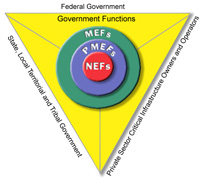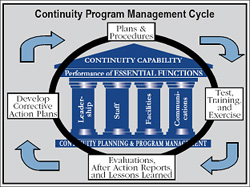This page is to support the COOP Division’s overarching goal and strategic objectives, each of the COOP Division Branches — Federal Branch; FEMA Branch; State, Territorial, Tribal, and Local (STTL) Branch; Regional Integration Branch; and Strategic Planning Branch has been aligned to a specific objective.The National Continuity Programs (NCP) COOP Division provides the foundation for the nation’s First Essential Function to ensure constitutional government under all conditions and ensures that Federal Executive Branch Departments and Agencies (D/As), including FEMA, continue to perform their Mission Essential Functions (MEFs) and Primary Mission Essential Functions (PMEFs) during a wide range of emergencies.
Upcoming Events
The Continuity Webinar Series is held on the 1st Wednesday of every month at 2 P.M. Eastern Time.
News and Resources
Please visit our resources page for further information on policy documents, continuity guidance, templates, training and more including: Continuity Guidance Circular 1 (CGC 1), Continuity Guidance Circular 2 (CGC 2), and Continuity Assistance Tool (CAT).
New Online Courses added!
IS- 545: Reconstitution Workshop for Continuity of Operations
IS-550: Continuity Exercise Design
Interested in the latest continuity news? Sign Up for GovDelivery Continuity Operations Updates!
What is Continuity of Operations?
 Continuity of Operations, as defined in the National Security Presidential Directive-51/Homeland Security Presidential Directive-20 (NSPD-51/HSPD-20) and the National Continuity Policy Implementation Plan (NCPIP), is an effort within individual executive departments and agencies to ensure that Primary Mission Essential Functions (PMEFs) continue to be performed during a wide range of emergencies, including localized acts of nature, accidents and technological or attack-related emergencies.
Continuity of Operations, as defined in the National Security Presidential Directive-51/Homeland Security Presidential Directive-20 (NSPD-51/HSPD-20) and the National Continuity Policy Implementation Plan (NCPIP), is an effort within individual executive departments and agencies to ensure that Primary Mission Essential Functions (PMEFs) continue to be performed during a wide range of emergencies, including localized acts of nature, accidents and technological or attack-related emergencies.
The Goal of Continuity
The ultimate goal of continuity in the executive branch is the continuation of National Essential Functions (NEFs). In order to achieve that goal, the objective for organizations is to identify their Essential Functions (EFs) and ensure that those functions can be continued throughout, or resumed rapidly after, a disruption of normal activities. The Federal Government has an important partnership with other non-federal government entities and with private sector owners and operators who play integral roles in ensuring our homeland security.
Continuity Program Management Cycle
 An organization’s resiliency is directly related to the effectiveness of its continuity capability. An organization’s continuity capability—its ability to perform its essential functions continuously—rests upon key components or pillars, which are in turn built on the foundation of continuity planning and program management. Those key pillars are Leadership, Staff, Communications, and Facilities. The continuity program staff within an agency shall coordinate and oversee the development and implementation of continuity plans and supporting procedures.
An organization’s resiliency is directly related to the effectiveness of its continuity capability. An organization’s continuity capability—its ability to perform its essential functions continuously—rests upon key components or pillars, which are in turn built on the foundation of continuity planning and program management. Those key pillars are Leadership, Staff, Communications, and Facilities. The continuity program staff within an agency shall coordinate and oversee the development and implementation of continuity plans and supporting procedures.
A standardized continuity program management cycle ensures consistency across all continuity programs and supports the foundation and pillars that comprise the nation’s continuity capability. It establishes consistent performance metrics, prioritizes implementation plans, promulgates best practices, and facilitates consistent cross-agency continuity evaluations.
